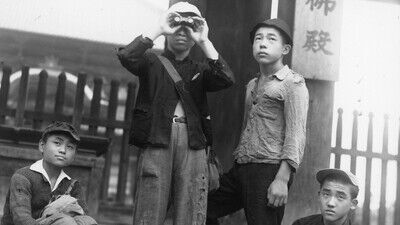While children factor into many of the director’s works, two sets of films from each movement in his career stand out. From his time at Shochiku are the films “Children in the Wind,” “Four Seasons of Children: Spring/Summer,” and “Four Seasons of Children: Autumn/Winter,” which relay two years in the life of brothers Zenta (Masao Hayama) and Sanpei (Bakudan-kozo). Similar to Ozu’s great films about brothers (“I Was Born But. . .” and “Good Morning”), Shimizu creates a whole world around Zenta and Sanpei, their joys and struggles with the neighborhood kids, the shift in adulation to actual understanding of their parents as flawed individuals, and of course their unshakable bond with each other. Shot once again in the country, Shimizu tempers the emotional realism of these films with a shimmering, golden light that captures the idyllic lens with which most of us would like to remember our childhoods.

From his postwar period, nothing can compare to the sheer emotional triumph of his orphan trilogy. His first film after departing from Shochiku, Shimizu self-produced “Children of the Beehive,” featuring a cast of children raised at the orphanage he founded. This ragtag group of boys finds a sense of family together and with a nameless soldier who helps the group find work as he takes them on a cross-country journey towards his old school Introspection Tower (itself featured in an earlier film by Shimizu of the same name). One boy cries for his mom every time he sees the sea, which is where she lost her life, and you will absolutely be crying, too. The docudrama “Children of the Beehive: What Happened Next” takes a meta-narrative approach to the story of the orphaned actors featured in the previous film, re-writing and updating their fictional and real-life stories with a thorough dose of optimism.
Finally, in “Children of the Great Buddha,” Ko (Sadao Nakamura) and Genji (Yoshio Kinuta), a pair of war orphans eke out a living through their knowledge of Japan’s cultural history, working as guides for tourists visiting the statues and temples of Japan’s ancient capital of Nara. Once again, Shimizu explores the plight of war orphans with empathy, the strength that can be found in makeshift families, and the transformative power of loving and being loved.
Presented in rare 35mm prints from archives and collections around the world, Hiroshi Shimizu Part I: The Shochiku Years screens at the Museum of Moving Image from May 4 — May 19, 2024, and Hiroshi Shimizu Part II: The Postwar and Independent Years screens at the Japan Society from May 16—June 1. For those who cannot make it to New York City, smaller Shimizu retrospectives will take place this summer at the Cinematheque in Vancouver, BC in Canada and the Pacific Film Archive in Berkeley, California.

